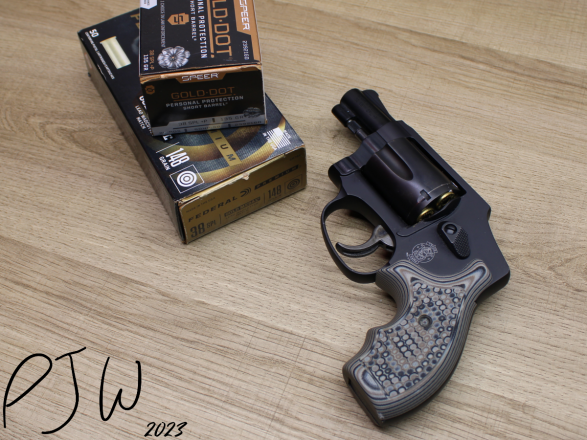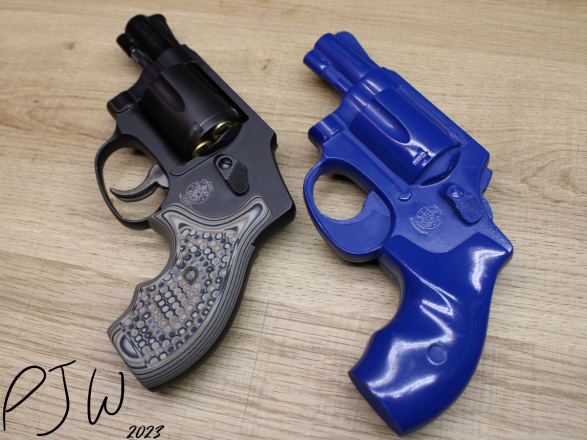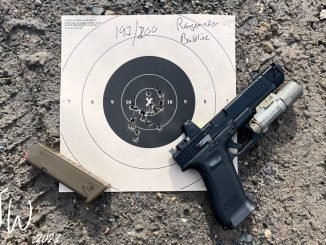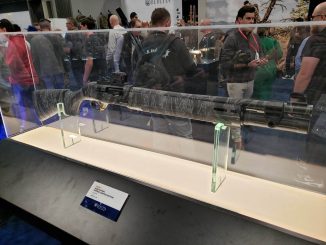
The Smith & Wesson J-Frame is a classic concealed carry revolver. The first models dropped in 1950, and they’ve evolved since. New models would release, such as the “Centennial” and the “Airweight”, with changes to design and materials used. The S&W 442 is a member of the J-Frame Airweight line, and was the only centerfire pocket gun that I tested in my first round of pocket pistol testing. What are the features of this gun, and how well does this pocket .38 do in the modern era?
This is a standalone review of the 442, building from my (Tiny) Pocket Pistol Roundup of 2023. In that article, I discuss my criteria for a pocket pistol, and gave short reviews of the guns that I had been testing at the time. The previous article isn’t required reading, but will help with painting the picture for what I look for in pocket guns.
What Is the Smith & Wesson 442?
The S&W 442 is a five shot revolver, chambered in .38SPL +P. This revolver is a double action only (DAO) hammer fired revolver, with a concealed hammer. The 442 has an aluminum frame, and uses a carbon steel cylinder and stainless barrel. While I’m not reviewing the 642, that revolver is very, very similar to the 442. The only difference is the finish on the gun, and the stainless steel used on the cylinder of the 642. Both guns have simple sights, with a small rear notch, and a medium front ramp.

While not a deep dive into the history of the J-Frame, we can cover part of the background of the 442. The 442 was derived from the Model 42 Centennial Airweight, which was released in 1952. The 42 had a goofy grip safety that needed to be depressed to fire the gun, however it still had an aluminum frame, and five shot capacity. The 442 would come out in the 1990s, as Smith was modernizing their J-Frame line.

We’ve got a basic, five shot .38 revolver, with an aluminum frame. The “Airweight” line is comprised of aluminum framed revolvers, which aids in reducing weight. Loaded, my 442 is 17 ounces with 148gr wadcutters, and 18 ounces with a BORAII Eagle pocket holster. MSRP is $539, but street price is closer to $400-$450. The gun ships with rubber stocks, but we’ll touch on the changes I’ve made to my gun shortly.
Now, there are a mess of different versions of the 442. Which one do I have, and what are the differences?
Which 442 is 4-You?
If you search “442” on Smith’s website, you’ll find five different guns. We’ll quickly cover them, and talk about the one that I’ve got.

There are two different “Performance Center” 442s, one with a moon clip-cut cylinder, and one that ships with Crimson Trace laser grips. The PC guns are supposed to have been worked over by the gunsmiths at Smith, however, reality paints some different pictures. From what I’ve been seeing online and from friends with current PC guns, the QC is not good. We’ll touch on modifications to the J-Frame in a bit, but the PC benefits aren’t worth the worse QC and higher price, at least to me.
The third 442 variant is an engraved model. It is a standard, non-PC 442, but with engraving and wood stocks. Personally, I think it is ugly, and Naked Snake has some things to say about engravings and advantages.
The final two options are the base model 442s, with one notable difference: the internal lock. The “Hillary Hole” was an internal lock that Smith started putting into revolvers in the 1990s, and they have been a blight upon the guns. They were intended to allow someone to lock the gun, so that it could not be fired. However, these locks have a tendency to cause issues with reliability over time. Both Dan and I have seen them break, especially in the lighter Airweight revolvers.

Mercifully, Smith offers a 442 without the internal lock. That model is the one that I’ve got, and the one that I would recommend. What’s the field strip and cleaning process like on the 442?
Field Stripping
The field stripping process is extremely easy and quick on the 442.
- Press the cylinder release forward, and swing the cylinder open.
- Dump rounds out of the cylinder (if loaded).
- Perform necessary maintenance or cleaning.
- Reload firearm, and close cylinder.
With the (essentially) single step field stripping process, this is a very easy gun to maintain. Cleaning a revolver will be more time intensive than a semi-auto gun, as we’ve essentially got extra barrels to clean, in the form of the cylinder. On the 442, that means 6 “barrels” to clean, with the barrel, and 5 charge holes of the cylinder. Other points to keep clean are the breech face and ejector star/ejector rod. I keep a light layer of oil on the exterior of the cylinder and barrel too, as in the heat of the summer, pocket guns get some sweat on them.

For “maintenance”, the two big things to also pretty simple. We want to make sure that the sideplate screws on the right side of the frame are tight, and that we keep the ejector rod tightened too. While not a massive concern, the ejector rod on the smaller frame Smith’s like to unscrew themselves over time, but we can easily tighten it with our hands. Despite what people think, revolvers can malfunction, but we can mitigate that by making sure that we maintain them.

With the 442 being a mature, 70+ year old design, the aftermarket is excellent. What have I done to modify my 442?
Modifying the 442
I picked up my 442 early in Summer 2022. Before I even fired the gun, I swapped some of the parts around on the revolver.

The first thing that I did was to modify the springs in the trigger/hammer assembly. The Wilson Combat Spring Kit is what I installed in the gun, which dropped the trigger pull weight a teeny bit, but made the trigger a little more responsive. Prior to swapping springs, the trigger felt a little sluggish when letting it out after a pull, but this has since alleviated the issue. Current pull weight is 10.5lbs.
Secondly, I swapped the factory rubber stocks for some Hogue G10 ones. The rubber stocks are comfortable for recoil control, but are way, way too grabby in the pocket. The G10 has a ton of texturing to keep the gun locked in the hand, but doesn’t grab on fabric when drawing from a pocket. The choice in revolver stocks are obviously very personal, but I’ve really enjoyed these Hogue ones.
The final modification that I made was a simple one, orange paint on the front sight. The sights on the 442 are very small, and are both black-on-black. As such, I wanted to make the front sight a bit more visible, which is something that I do on most carry guns. A few coats of high visibility orange paint, and the sight picture is a lot better now.
Talking through my mods, I’ve done less work on this than the LCP 22, and more than the LCR 22. I don’t think that the spring kit was a “necessary” upgrade, but I prefer the trigger pull with it. The stocks and front sight paint were necessary, at least for me. Without the paint, shooting was a fair bit harder, and the G10 stocks certainly made drawing and shooting easier for me. Speaking of the shooting, lets get into the reliability and ergonomics of the 442.
Reliability & Ergonomics
Over the last 15 months, I’ve shot a wide range of .38SPL through the 442. From lighter FMJs to heavier LRN, to wadcutters and +P carry ammo, we had no issues. Hell, I even tested .38 snakeshot in the gun. Every time that the gun was loaded, it fired when the trigger was pulled. The round count as of this time is about 1100 rounds of standard pressure .38SPL, and 80 rounds of +P.

Ergonomically, the 442 is a generally comfortable gun to shoot, albeit, with a degree of stout recoil. We’ve only got 3 controls on the gun, in the form of the trigger, cylinder release, and ejector rod. All three are designed to work well with human hands, and the general profile of the gun makes carriage and drawing easy. We can modify the grip by swapping stocks, and even with my tiny Hogues, I still get a pretty solid grip. My pinky dangles off the bottom, which I can tuck beneath the gun to provide more grip.
Now, it isn’t totally perfect.
The 442 has a “humpback” frame, used to conceal the hammer. While I’ve got no issues with the humpback itself, the left and right sides of it have fairly sharp, mostly 90 degree angles. Combining my higher grip and this design, I’ve sliced open my thumb during range trips that are over about 80 rounds. Now, 80 rounds through an Airweight is a lot, but I actually enjoy shooting it. I can certainly blend the back and sides of the humpback to fix this, but it is an annoying design feature.
So the gun is reliable, and is comfortable when it’s not shearing skin. How’s my performance with the 442?
The Smith 442 At the Range – Shooting Performance
I can’t lie, I really enjoy shooting the 442. It isn’t an easy gun to shoot, but with a degree of skill, you can put in work with it. There are two things that I find that make shooting this gun harder.

The 442 has fairly small sights. Compared to the other pocket guns I’ve tested, I’d say that these are the worst. They aren’t horrible, but they don’t make accurate and fast shooting all that easy. I feel confident with them out to about 15 yards, but they aren’t easy for most people to use.
Secondly, the 442 is light. It’s in the “Airweight” name, but even weaker .38SPL loads are still fairly stout in this gun. We make concessions to have a lighter carry gun, and more recoil is certainly that.

Despite the rougher sights and light weight, this gun shoots fairly well. The trigger is fairly good for a DAO pocket revolver, and the ability to get a solid grip on the gun has lead to some good scores from me. I use the Hardwired Tactical Super Snubby Test as a way to compare pocket guns, and I’ve gotten some pretty good scores on that drill. I generally shoot the advanced version, to work in a drawstroke.
The idea of accuracy and speed really comes into play with the 442. We need to be accurate, but we also generally want to shoot reasonably fast. The 442 is a gun that requires a lot of focus, and you’ll need to slow down to actually get solid hits. I shoot the 442 a fair bit slower than the LCR22, which makes sense when you factor in the recoil element. However, I still shoot the 442 better than I expected to. For a full playlist of my 442 drills, check here.
A light pocket .38SPL isn’t an easy gun to shoot, but if you put in the time, you can get pretty confident with it. How is carrying the 442?
Carrying the 442
The 442 carries like a dream. While not the lightest pocket revolver, it has a svelte profile that just fits well in a pocket. During my testing period with it, I mostly carried in a Galco Pocket Protector, and a BORAI Eagle.
The larger Pocket Protector is my go-to when wearing pants with deeper pockets, while the Eagle works well in slightly more shallow pockets. The shorts that I wear generally don’t have very deep pockets, so I’ve been using the Eagle a lot in the warmer seasons. While not holster reviews, I’ve certainly liked using both of these holsters with the 442.
Part of what makes the 442 so conducive for pocket carry is the overall shape. The design fits well into a pocket, as it isn’t very tall. The humpback acts as a great point to place your thumb while pulling the gun from the pocket, as we can easily keep it there to shoot from retention.
Ammo wise, I carry 148gr Federal Gold Medal Match wadcutters in the gun, and Speer Gold Dot 135gr +P JHP in a speedstrip. While the 442 is a second gun/BUG for me, I’ve found that a reload for it basically takes up no space, so I’ve been carrying one in a cargo pocket. Speedstrips require a lot of practice to get good with, but that’s part and parcel with shooting a snubby.

When I’m out hiking, I’ve been loading CCI snakeshot into the 442. My friends and I often find ourselves on much less traveled trails, so having a few charge holes to deal with snakes is cheap insurance.
Compared to the LCR, the 442 carries better. The LCP is still the most comfortable pocket gun that I’ve tested, but the 442 isn’t far behind. What are some .38SPL specific considerations?
A .38 In the Pocket
When carrying a pocket .38, there are two major factors that we need to address: ammo selection, and mindset.
With the 442, we’ve got fixed sights, which means that we’ve got to find an ammo that tends to have a point of impact that is very close to our point of aim. For my specific gun, heavier wadcutters tend to shoot pretty close to the sights. I carry Federal 148gr Gold Medal Match ones in the gun, as they shoot accurately, are low recoil, and have good terminal ballistics. Unfortunately, they are hard to quickly load into the gun due to the projectile shape. As such, my reload is the Speer Gold Dot 135gr +P, as it also shoots to the sights well, and is easy to reload into the cylinder. Dan wrote a great article about wadcutters, which I’d recommend you read. Needless to say, ammo selection is extremely important with the .38 snubby.

Our second factor is mindset. The .38SPL J-Frame is a “get out of trouble” gun, not one that we would use to “get into trouble”. We’ve got a compact gun, with low capacity and a degree of difficulty to shoot well. This is a gun for trying to solve our immediate problem, not one to go solve all of the world’s problems with. While our terminal ballistics are generally favorable, we’ve got to make the rounds in the gun count. Much like the .22LR reviews, we’ve got to understand that our pocket gun is for getting out of trouble, not for looking for it.
If we can select ammo that works well in the gun, and understand the limitations of the gun, the pocket .38SPL can certainly be a solid carry gun.
Pros Of the 442
Pros:
- Extremely tested design
- Good terminal ballistics
- Simple maintenance protocol
- Excellent aftermarket (holsters/stocks/internal parts)
- Slimline profile, excels in pocket carry
- Extremely simple operation
- Good trigger
The 442 (and many Airweight .38 J-Frames) are the poster children for pocket carried revolvers. They’ve been doing the job for a long time, and that is a very important data point. The two other guns that I’ve extensively tested thus far (LCP 22 & LCR 22) are both fairly new guns, but the 442 has roots to 70 years ago. The tried and tested design has a great aftermarket, and is generally pretty simple to maintain. Terminal ballistics are also fairly good, as .38SPL is is a very capable cartridge, even in this compact footprint.
The 442 is a very easy gun to understand, and to (begin) to use. We’ve got 3 controls on the gun, with all of them being designed well and intuitive to use. The trigger on the 442 is generally quite good, and can be improved fairly easily too. There’s a reason why the J-Frame has persisted, and a big part of that is the simplicity and ease of carry.
Now, this sounds pretty positive, but I’ve got a lot of gripes with the 442.
Cons Of the 442
Cons:
- Low capacity
- Harsh recoil
- Poor sights
- Some sharp angles on gun (humpback)
- Reasonably high cost ammunition
- Extremely steep learning curve
The 442 is a low capacity gun, with only five rounds. We’ve also got fairly stout recoil, as the gun is lightweight. The sights aren’t the worst that I’ve used, but they are far from great. There are some slightly sharp angles on the gun too, which can certainly tear up your hands, depending on how you grip the gun.
One element that I didn’t touch on was the caliber’s cost. 38SPL is not a cheap round to purchase and plink with. Compared to 9mm, we’re looking at about 60-100% more cost for training/practice ammo. Now, that’s a fairly big con, as the 442 is a gun that you need to be able to practice with to actually shoot better with it.
This is a gun for advanced shooters. While the skill floor on the 442 is extremely low, the skill ceiling is very high. Learning how to operate the 442 is easy, but getting good with it requires a metric ton of time and effort.
The Verdict
I very much like the Smith 442. It’s a gun that I’ve carried a ton, and shot a ton too. It’s come with me on cross-country trips, hikes in the mountains, and on everyday errand runs. The Airweight J-Frame is a gun that just feels natural in a pocket, and with .38SPL, you know that you’ve got a round with good terminal performance, as long as you put in your part.

Despite my enjoyment for the 442, I am under no illusion that it is a gun that has caveats. An Airweight .38SPL is an exceptionally hard gun to shoot well. It’s low capacity too, so it is not forgiving for missed shots. A lot of practice has to go into shooting the 442 to get good with it, something that many people may not be able to do. As such, I call it a “Situationally Great Classic”, as it is a gun that has specific situations in which I would recommend it.
The 442 is a gun for people already “in the know”. If you have the ability to shoot an Airweight well, you likely already own one or two. If you want a .38SPL J-Frame and don’t care about increased weight, something like the Smith 640 will work better. The 442 is a gun that requires a fairly high degree of skill to use, but if you have that ability, you’ll likely love this gun. It’s always been a pocket/BUG for me, as a secondary pistol. However, this is a gun that I would feel confident with, if I needed a deep concealment/true NPE invisible gun.
If you understand the downsides and degree of effort that goes into shooting the 442 well, you may want to pick one up. If you’d prefer a snubby that’s easier to shoot, something like the LCR 22 or 43C/351C may be more up your alley. While there is a trade off in ballistic effect, the general ease of use is often well worth the trade.
Further Reading & Related Reviews
The Smith 442 was the final full review that was tied to my initial pocket pistol testing. There will be another article coming soon, giving an overview of the guns again, and “ranking” them. However, we’ll be testing even more guns in the future. If there is a specific gun that you think I should test out, leave a comment about it!
The first “roundup” is linked down below, along with the LCR 22 and Lite Rack reviews:
>>The (Tiny) Pocket Pistol Roundup of 2023<<





2 Trackbacks / Pingbacks